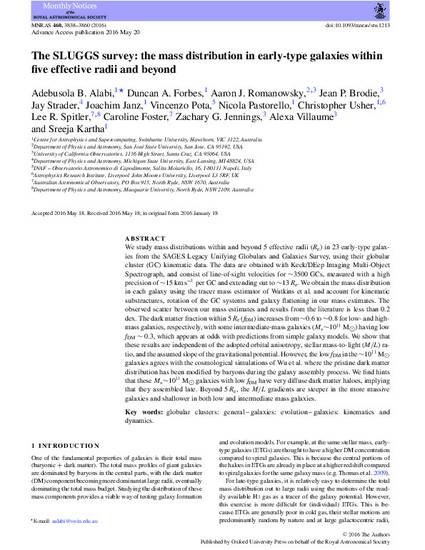
Article
The SLUGGS survey: the mass distribution in early-type galaxies within five effective radii and beyond
Monthly Notices of the Royal Astronomical Society
(2016)
Abstract
We study mass distributions within and beyond 5 effective radii (Re) in 23 early-type galaxies from the SAGES Legacy Unifying Globulars and Galaxies Survey, using their globular cluster (GC) kinematic data. The data are obtained with Keck/DEep Imaging Multi-Object Spectrograph, and consist of line-of-sight velocities for ∼3500 GCs, measured with a high precision of ∼15 km s−1 per GC and extending out to ∼13 Re. We obtain the mass distribution in each galaxy using the tracer mass estimator of Watkins et al. and account for kinematic substructures, rotation of the GC systems and galaxy flattening in our mass estimates. The observed scatter between our mass estimates and results from the literature is less than 0.2 dex. The dark matter fraction within 5 Re (fDM) increases from ∼0.6 to ∼0.8 for low- and high-mass galaxies, respectively, with some intermediate-mass galaxies (M* ∼ 1011 M⊙) having low fDM ∼ 0.3, which appears at odds with predictions from simple galaxy models. We show that these results are independent of the adopted orbital anisotropy, stellar mass-to-light (M/L) ratio, and the assumed slope of the gravitational potential. However, the low fDM in the ∼1011 M⊙ galaxies agrees with the cosmological simulations of Wu et al. where the pristine dark matter distribution has been modified by baryons during the galaxy assembly process. We find hints that these M* ∼ 1011 M⊙ galaxies with low fDM have very diffuse dark matter haloes, implying that they assembled late. Beyond 5 Re, the M/L gradients are steeper in the more massive galaxies and shallower in both low and intermediate mass galaxies.
Keywords
- globular clusters: general,
- galaxies: evolution,
- galaxies: kinematics and dynamics
Disciplines
Publication Date
August, 2016
DOI
10.1093/mnras/stw1213
Publisher Statement
This article has been accepted for publication in Monthly Notices of the Royal Astronomical Society ©: 2016 The Authors. Published by Oxford University Press on behalf of the Royal Astronomical Society. All rights reserved.
This article is also available online at the following link: http://dx.doi.org/10.1093/mnras/stw1213
Citation Information
Adebusola B. Alabi, Duncan A. Forbes, Aaron J. Romanowsky, Jean P. Brodie, et al.. "The SLUGGS survey: the mass distribution in early-type galaxies within five effective radii and beyond" Monthly Notices of the Royal Astronomical Society Vol. 460 Iss. 4 (2016) p. 3838 - 3860 ISSN: 1365-2966 Available at: http://works.bepress.com/aaron_romanowsky/94/
